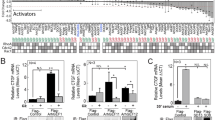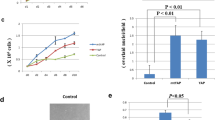Abstract
CrkII belongs to the adaptor protein family that plays a crucial role in signal transduction. In order to better understand the biological functions of CrkII, we focused on the regulation of gene expression by CrkII. Various transcriptional control elements were examined for their activation by CrkII-expression, and we found that CrkII selectively activates the serum response element (SRE), a transcriptional control element of immediate-early genes. This SRE activation induced by CrkII-overexpression was mediated by the serum response factor (SRF) via Rho. Indeed, we confirmed that the amount of activated Rho was increased in the CrkII-expressing cells. Moreover, we showed that when overexpressed, CrkII induces the cellular transformation of NIH 3T3 cells and that a dominant negative mutant of Rho suppresses this transformation, strongly suggesting that activation of Rho is essential for the transforming activity by CrkII. Furthermore, we also found that CrkII and Gα12, a member of the heterotrimeric G proteins, synergistically activates Rho as well as the SRF, and that an SH3 mutant of CrkII can inhibit the Gα12-induced activation of SRF. These results strongly suggest that CrkII is involved in the activation of Rho and SRF by Gα12. Our study provides strong evidence that Rho activation plays a crucial role in CrkII-mediated signals to induce gene expression and cellular transformation.
This is a preview of subscription content, access via your institution
Access options
Subscribe to this journal
Receive 50 print issues and online access
$259.00 per year
only $5.18 per issue
Buy this article
- Purchase on Springer Link
- Instant access to full article PDF
Prices may be subject to local taxes which are calculated during checkout









Similar content being viewed by others
References
Aghazadeh B, Lowry WE, Huang XY and Rosen MK . (2000). Cell. 102, 625–633.
Akagi T, Ono H, Nyunoya H and Shimotohno K . (1997). Oncogene, 14, 2071–2078.
Akagi T, Shishido T, Murata and Hanafusa H . (2000). Proc. Natl. Acad. Sci. USA, 97, 7290–7295.
Alley MC, Pacula-Cox CM, Hursey ML, Rubinstein LR and Boyd MR . (1991). Cancer Res., 51, 1247–1256.
Altun-Gultekin ZF, Chandriani S, Bougeret C, Ishizaki T, Narumiya S, de Graaf P, Van Bergen en Henegouwen P, Hanafusa H, Wagner JA and Birge RB . (1998). Mol. Cell. Biol., 18, 3044–3058.
Arthur WT, Petch LA and Burridge K . (2000). Curr. Biol., 10, 719–722.
Ayer DE, Laherty CD, Lawrence QA, Armstrong AP and Eisenman RN . (1996). Mol. Cell. Biol., 16, 5772–5781.
Birge RB, Knudsen BS, Besser D and Hanafusa H . (1996). Genes Cells, 1, 595–613.
Brouns MR, Matheson SF and Settleman J . (2001). Nat. Cell Biol., 3, 361–367.
Casamassima A and Rozengurt E . (1997). J. Biol. Chem., 272, 9363–9370.
Chan AM, Fleming TP, McGovern ES, Chedid M, Miki and Aaronson SA . (1993). Mol. Cell. Biol., 13, 762–768.
Chang JH, Gill S, Settleman J and Parsons SJ . (1995). J. Cell Biol., 130, 355–368.
Cheresh DA, Leng J and Klemke RL . (1999). J. Cell Biol., 146, 1107–1116.
Chikumi H, Fukuhara S and Gutkind JS . (2002). J. Biol. Chem., 277, 12463–12473.
Cho SY and Klemke RL . (2000). J. Cell Biol., 149, 223–236.
Collins LR, Minden A, Karin M and Brown JH . (1996). J. Biol. Chem., 271, 17349–17353.
Davis RJ . (2000). Cell, 103, 239–252.
Dolfi F, Garcia-Guzman M, Ojaniemi M, Nakamura H, Matsuda M and Vuori K . (1998). Proc. Natl. Acad. Sci. USA, 95, 15394–15399.
Feller SM . (2001). Oncogene, 20, 6348–6371.
Fromm C, Coso OA, Montaner S, Xu N and Gutkind JS . (1997). Proc. Natl. Acad. Sci. USA, 94, 10098–10103.
Fujii M, Chuhjo T, Minamino T, Masaaki N, Miyamoto K and Seiki M . (1995). Oncogene, 11, 7–14.
Fukuhara S, Chikumi H and Gutkind JS . (2000). FEBS Lett., 485, 183–188.
Fukuhara S, Murga C, Zohar M, Igishi T and Gutkind JS . (1999). J. Biol. Chem., 274, 5868–5879.
Gille H, Sharrocks AD and Shaw PE . (1992). Nature, 358, 414–417.
Gohla A, Harhammer R and Schultz G . (1998). J. Biol. Chem., 273, 4653–4659.
Gotoh T, Hattori S, Nakamura S, Kitayama H, Noda M, Takai Y, Kaibuchi K, Matsui H, Hatase O, Takahashi H, Kurata T and Matsuda M . (1995). Mol. Cell. Biol., 15, 6746–6753.
Greenberg ME and Ziff EB . (1984). Nature, 311, 433–438.
Gumienny TL, Brugnera E, Tosello-Trampont AC, Kinchen JM, Haney LB, Nishiwaki K, Walk SF, Nemergut ME, Macara IG, Francis R, Schedl T, Qin Y, Van Aelst L, Hengartner MO and Ravichandran KS . (2001). Cell, 107, 27–41.
Hart MJ, Jiang X, Kozasa T, Roscoe W, Singer WD, Gilman AG, Sternweis PC and Bollag G . (1998). Science, 280, 2112–2114.
Haskell MD, Nickles AL, Agati JM, Su L, Dukes BD and Parsons SJ . (2001). J. Cell Sci., 114, 1699–1708.
Herschman HR . (1991). Annu. Rev. Biochem., 60, 281–319.
Hill CS and Treisman R . (1995). EMBO J., 14, 5037–5047.
Hill CS, Wynne J and Treisman R . (1995). Cell, 81, 1159–1170.
Hu W, Bellone CJ and Baldassare JJ . (1999). J. Biol. Chem., 274, 3396–3401.
Jiang H, Wu D and Simon MI . (1993). FEBS Lett., 330, 319–322.
Johansen FE and Prywes R . (1994). Mol. Cell. Biol., 14, 5920–5928.
Katoh H, Aoki J, Yamaguchi Y, Kitano Y, Ichikawa A and Negishi M . (1998). J. Biol. Chem., 273, 28700–28707.
Khosravi-Far R, Solski PA, Clark GJ, Kinch MS and Der CJ . (1995). Mol. Cell. Biol., 15, 6443–6453.
Kiyokawa E, Hashimoto Y, Kobayashi S, Sugimura H, Kurata T and Matsuda M . (1998). Genes Dev., 12, 3331–3336.
Kizaka-Kondoh S, Matsuda M and Okayama H . (1996). Proc. Natl. Acad. Sci. USA, 93, 12177–12182.
Klemke RL, Leng J, Molander R, Brooks PC, Vuori K and Cheresh DA . (1998). J. Cell Biol., 140, 961–972.
Kozasa T, Jiang X, Hart MJ, Sternweis PM, Singer WD, Oilman AG, Bollag G and Sternweis PC . (1998). Science, 280, 2109–2111.
Kranenburg O, Poland M, van Horck FP, Drechsel D, Hall A and Moolenaar WH . (1999). Mol. Biol. Cell, 10, 1851–1857.
Lau LF and Nathans D . (1985). EMBO J., 4, 3145–3151.
Lin R, Cerione RA and Manor D . (1999). J. Biol. Chem., 274, 23633–23641.
Lowry WE, Huang J, Ma YC, Ali S, Wang D, Williams DM, Okada M, Cole PA and Huang XY . (2002). Dev. Cell, 2, 733–744.
Mao J, Xie W, Yuan H, Simon MI, Mano H and Wu D . (1998a). EMBO J., 17, 5638–5646.
Mao J, Yuan H, Xie W, Simon MI and Wu D . (1998b). J. Biol. Chem., 273, 27118–22723.
Mao J, Yuan H, Xie W and Wu D . (1998c). Proc. Natl. Acad. Sci. USA, 95, 12973–12976.
Matsuda M, Tanaka S, Nagata S, Kojima A, Kurata T and Shibuya M . (1992). Mol. Cell. Biol., 12, 3482–3489.
Mayer BJ, Hamaguchi M and Hanafusa H . (1988). Nature, 332, 272–275.
Meijne AM, Ruuls-Van Stalle L, Feltkamp CA, McCarthy JB and Roos E . (1997). Exp. Cell Res., 234, 477–485.
Mizushima S and Nagata S . (1990). Nucleic Acids Res., 18, 5322.
Morgenstern JP and Land H . (1990). Nucleic Acids Res., 18, 3587–3596.
Morita S, Kojima T and Kitamura T . (2000). Gene Ther., 7, 1063–1066.
Nagao M, Kaziro Y and Itoh H . (1999). Oncogene, 18, 4425–4434.
Nakashima N, Rose DW, Xiao S, Egawa K, Martin SS, Haruta T, Saltiel AR and Olefsky JM . (1999). J. Biol. Chem., 274, 3001–3008.
Nolan KM, Barrett K, Lu Y, Hu KQ, Vincent S and Settleman J . (1998). Genes Dev., 12, 3337–3342.
Olson MF, Paterson HF and Marshall CJ . (1998). Nature, 394, 295–299.
Posern G, Rapp UR and Feller SM . (2000). Oncogene, 19, 6361–6368.
Prasad MV, Dermott JM, Heasley LE, Johnson GL and Dhanasekaran N . (1995). J. Biol. Chem., 270, 18655–18659.
Reichman CT, Mayer BJ, Keshav S and Hanafusa H . (1992). Cell Growth Differ., 3, 451–460.
Ren XD, Kiosses WB and Schwartz MA . (1999). EMBO J., 18, 578–585.
Senechal K, Halpern J and Sawyers CL . (1996). J. Biol. Chem., 271, 23255–23261.
Senechal K, Heaney C Druker B and Sawyers CL . (1998). Mol. Cell Biol., 18, 5082–5090.
Shi CS, Sinnarajah S, Cho H, Kozasa T and Kehrl JH . (2000). J. Biol. Chem., 275, 24470–24476.
Shishido T, Akagi T, Chalmers A, Maeda M, Terada T, Georgescu MM and Hanafusa H . (2001). Genes Cells, 6, 431–440.
Smith JJ, Richardson DA, Kopf J, Yoshida M, Hollingsworth RE and Kornbluth S . (2002). Mol. Cell. Biol., 22, 1412–1423.
Stam JC, Geerts WJ, Versteeg HH, Verkleij AJ and van Bergen en Henegouwen PM . (2001). J. Biol. Chem., 276, 25176–25183.
Tanaka S, Ouchi T and Hanafusa H . (1997). Proc. Natl. Acad. Sci. USA, 94, 2356–23561.
ten Hoeve J, Morris C, Heisterkamp N and Groffen J . (1993). Oncogene, 8, 2469–2474.
Tolkacheva T, Feuer B, Lorenzi MV, Saez R and Chan AM . (1997). Oncogene, 15, 727–735.
Treisman R . (1994). Curr. Opin. Genet. Dev., 4, 96–101.
Treisman R . (1995). EMBO J., 14, 4905–4913.
Treisman R . (1996). Curr. Opin. Cell Biol., 8, 205–215.
Tsuda M, Tanaka S, Sawa H, Hanafusa H and Nagashima K . (2002). Cell Growth Differ., 13, 131–139.
Voyno-Yasenetskaya TA, Faure MP, Ahn NG and Bourne HR . (1996). J. Biol. Chem., 271, 21081–21087.
Voyno-Yasenetskaya TA, Pace AM and Bourne HR . (1994). Oncogene, 9, 2559–2565.
Welsh CF, Roovers K, Villanueva J, Liu Y, Schwartz MA and Assoian RK . (2001). Nat. Cell Biol., 3, 950–957.
Xu N, Bradley L, Ambdukar I and Gutkind JS . (1993). Proc. Natl. Acad. Sci. USA, 90, 6741–6745.
Zheng Y Olson MF, Hall A, Cerione RA and Toksoz D . (1995). J. Biol. Chem., 270, 9031–9034.
Zohn IE, Klinger M, Karp X, Kirk H, Symons M, Chrzanowska-Wodnicka M, Der CJ and Kay RJ . (2000). Oncogene, 19, 3866–3877.
Acknowledgements
We thank RN Eisenman, A Hall, H Itoh, S Narumiya, and T Ouchi for providing the plasmids, T Kitamura for Plat-E cells, and M Yutsudo for the facilities of viral infections. We also thank Y Fujitsuka and other members of the Hanafusa laboratory for the technical assistance and helpful discussions. TI thanks S Yamasaki, J Yamauchi, M Yoneda, and T Yamamoto for valuable discussions and encouragement. This work was supported by a grant-in-aid for Specially Promoted Research from the Ministry of Education, Sports, and Culture of Japan.
Author information
Authors and Affiliations
Corresponding author
Rights and permissions
About this article
Cite this article
Iwahara, T., Akagi, T., Shishido, T. et al. CrkII induces serum response factor activation and cellular transformation through its function in Rho activation. Oncogene 22, 5946–5957 (2003). https://doi.org/10.1038/sj.onc.1206633
Received:
Revised:
Accepted:
Published:
Issue Date:
DOI: https://doi.org/10.1038/sj.onc.1206633
Keywords
This article is cited by
-
The adaptor protein CrkII regulates IGF-1-induced biological behaviors of pancreatic ductal adenocarcinoma
Tumor Biology (2016)
-
Crk adaptor proteins act as key signaling integrators for breast tumorigenesis
Breast Cancer Research (2012)
-
Proteins that bind the Src homology 3 domain of CrkI have distinct roles in Crk transformation
Oncogene (2010)
-
Involvement of adaptor protein Crk in malignant feature of human ovarian cancer cell line MCAS
Oncogene (2006)



